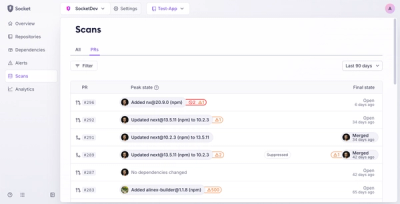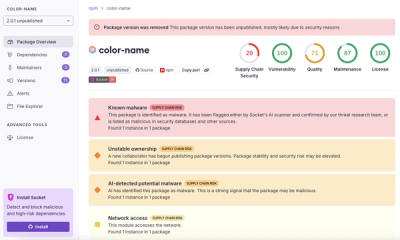
Product
Introducing Pull Request Stories to Help Security Teams Track Supply Chain Risks
Socket’s new Pull Request Stories give security teams clear visibility into dependency risks and outcomes across scanned pull requests.
A python package providing functionality for matching words that can be confused for eachother, but contain different characters
Confusables is a python package that provides functionality for analyzing and matching words that "appear" to be the same or similar, but use different characters.
Confusables uses the unicode confusable characters list (https://www.unicode.org/Public/security/8.0.0/confusables.txt) along with other methods of matching characters.
This package can be used for any application where detecting words using any unexpected characters to pass filters is required. This could include finding malicious fake website names, analyzing or normalizing text data, or even detecting attempts to get past a profanity filter.
Confusables can be installed through pip using
pip3 install confusables
The functions in the confusables module focus around comparing and finding strings that can be considered "confusable". This means that they can be humanly interpretable as the same string. Since this deals with human interpretation, the "confusable" definition is loose, and in later versions may be more or less strict.
Currently, confusables provides: is_confusable, confusable_characters, and confusable_regex
is_confusable(string1, string2) takes in 2 strings and outputs whether or not the two are "confusable". Keep in mind that in some cases, a single character can be confusable with 2 characters combined (eg. ‼ is a single character, !! is two)
from confusables import is_confusable
print(is_confusable('rover', 'Ʀỏ𝕍3ℛ'))
# prints True
confusable_characters(char) takes in a character and outputs a list of characters that are confusable with it. In some cases, as mentioned above, a single characters can be confusables with multiple characters, in which case those characters will be inluded in the list in the form of a string.
from confusables import confusable_characters
print(confusable_characters('c'))
# prints ['ċ', 'ᴄ', '𝔠', '𝒄', '𝗰', '𝗖', 'ḉ', 'ℂ', 'Ꮯ', 'ć', 'c̦', '𝑐', '𝓬', '𝚌', '𐌂', 'Ⅽ', 'С', '𝘤', 'c', 'ҫ', '𝖈', '🝌', '𝖢', '𝐂', 'C', '𝓒', 'Ç', '𝘾', 'ç', 'Ⲥ', 'с', 'ⅽ', 'ĉ', '𐔜', 'c', 'ℭ', 'ϲ', '𑣩', 'Ϲ', '𝕮', 'č', '𐊢', 'Ĉ', '𝑪', 'C', '𑣲', '𐐕', '𐐽', 'ⲥ', '𝐶', 'Ċ', 'C̦', 'ꮯ', '𝒞', '𝕔', '𝘊', 'Č', 'ꓚ', '𝒸', '𝐜', '𝙲', '𝖼', 'Ć', '𝙘', 'Ḉ']
confusable_regex(string, include_character_padding=False) takes a string and outputs a regex string that matches words that are confusable with the input string.
from confusables import confusable_regex
import re
regex_string = confusable_regex('bore', include_character_padding=True)
regex = re.compile(regex_string)
print(regex.search('Sometimes people say that life can be a ь.𝞂.ř.ɜ, but I don\'t agree'))
# prints <_sre.SRE_Match object; span=(40, 47), match='ь.𝞂.ř.ɜ'>
normalize(string, prioritize_alpha=False) takes a string and outputs a list of possible "normal forms". This means that characters in the string get converted to their confusable ascii counterparts. The prioritize_alpha option means the outputted options will prioritize converting characters to characters of the latin alphabet over any others. This option is recommended when natural language is expected.
from confusables import normalize
print(normalize('Ʀỏ𝕍3ℛ', prioritize_alpha=True))
# prints ['rov3r', 'rover']
print(normalize('Ʀỏ𝕍3ℛ', prioritize_alpha=False))
# prints ['r0v3r', 'r0ver', 'ro\'v3r', 'ro\'ver', 'rov3r', 'rover']
If you find the latest version of this package to have an out of date version of the unicode official confusables.txt, then why not submit a PR to update it!
First, find out what the latest version of unicode confusables is. Then, run
make update VERSION=X.Y.Z
Next, run
make parse
And that's it! Commit your changes and create a pull request.
This module is something I put together because I'm interested in the field of language processing. I'm hoping to build out it's functionality, and I'm more than happy to take suggestions!
Additionally, I think the effectiveness of the module could be greatly improved using some machine learning models, and I'm currently on the hunt for some useful data sets. Please let me know if you know of any!
You can contact me through any normal Github means, or using my email, woodgern@gmail.com
FAQs
A python package providing functionality for matching words that can be confused for eachother, but contain different characters
We found that confusables demonstrated a healthy version release cadence and project activity because the last version was released less than a year ago. It has 1 open source maintainer collaborating on the project.
Did you know?

Socket for GitHub automatically highlights issues in each pull request and monitors the health of all your open source dependencies. Discover the contents of your packages and block harmful activity before you install or update your dependencies.

Product
Socket’s new Pull Request Stories give security teams clear visibility into dependency risks and outcomes across scanned pull requests.

Research
/Security News
npm author Qix’s account was compromised, with malicious versions of popular packages like chalk-template, color-convert, and strip-ansi published.

Research
Four npm packages disguised as cryptographic tools steal developer credentials and send them to attacker-controlled Telegram infrastructure.